Fermented Garlic Honey | Recipe And Benefits
Fermented Garlic Honey is a very simple recipe to make and a great ferment to have on hand for cold and flu season. All it requires is peeling garlic cloves and pouring honey over them. Simple, however you will need some patience while the fermenting process takes place. Weeks to months depending on how mellow you’d like the garlic to be. The honey does taste great just a few days in though so sampling it early is inevitable.
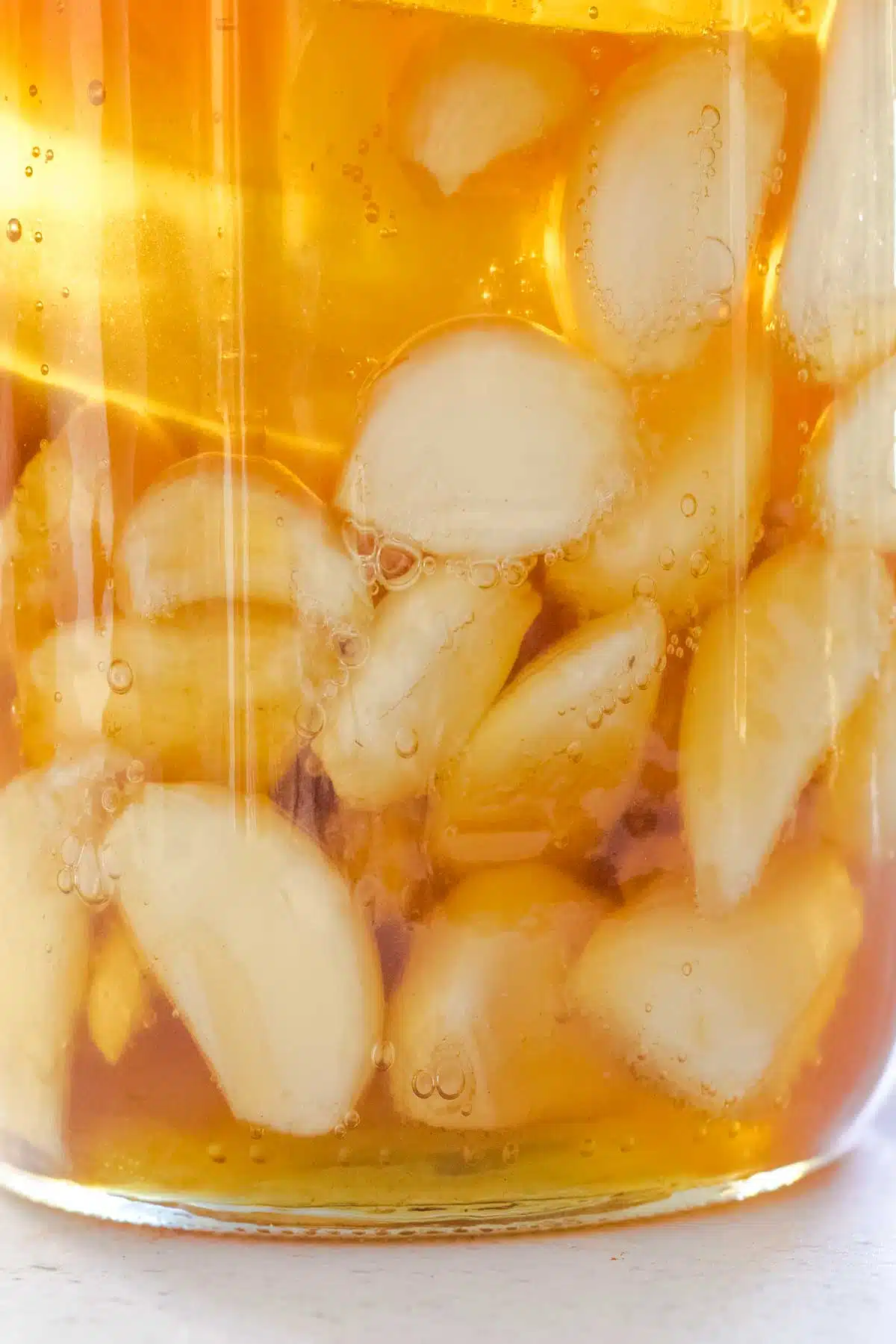
This post may contain affiliate links. If you click one of these links and make a purchase, I may earn a commission at no additional cost to you.
In This Article
Is It Safe To Eat Fermented Garlic In Honey?
Let’s address this one straight up. Something that causes a lot of concern with this ferment is the risk of botulism spores growing. Many blogs mention it and suggest it’s not safe to make. However, to date, there has not been one single documented case of botulism contamination relating to honey-fermented garlic.
Clostridium botulinum (CB) can be found in soil and as a result, it can be present in foods such as garlic. It can also be present in honey (and mostly harmful to infants here). That is not to say that adding the two together = botulism.
CB needs a neutral pH, a moist environment, and no oxygen to thrive. It’s important to note that food preservatives, like sugar, inhibit it. That includes honey.
Honey is roughly 80% sugar and 20% water so qualifies as a high-sugar, low-moisture food. The garlic does produce a little moisture, which slightly dilutes the mix. It’s not enough to make it troublesome though. There are also the protective effects of the fermentation process.
With this in mind – I feel it is a safe and very nourishing ferment to make – but you need to make that decision for yourself. If you are concerned, you can also keep it in the fridge to ease your mind.
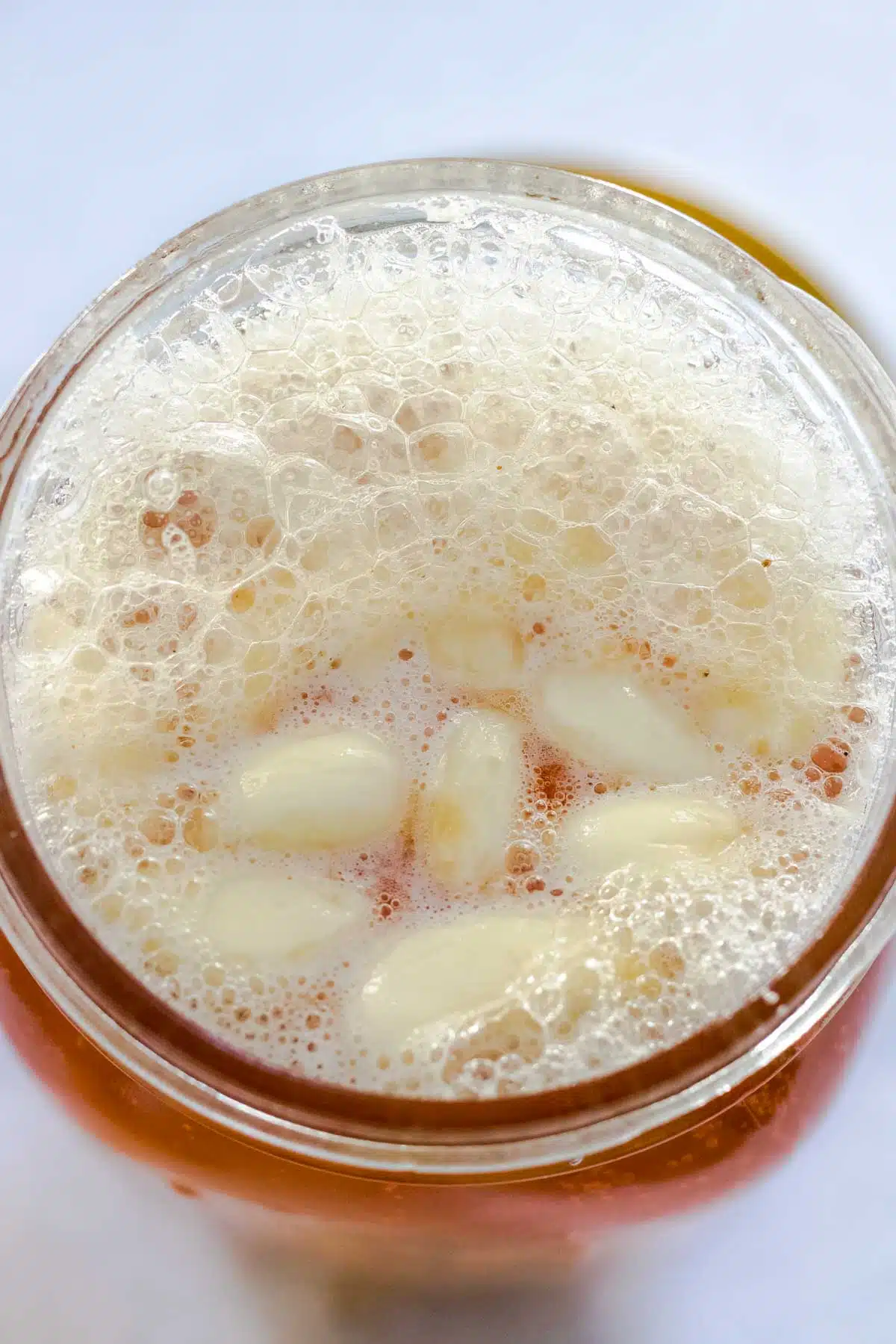
Ingredients Needed For A Garlic Honey Recipe
You will only need two very simple ingredients here. Any amount of garlic you like and your favourite raw local honey. That’s it! The only other ingredient is time, because this ferment tastes better the longer it sits. The flavours slowly meld together making the garlic much more mellow.
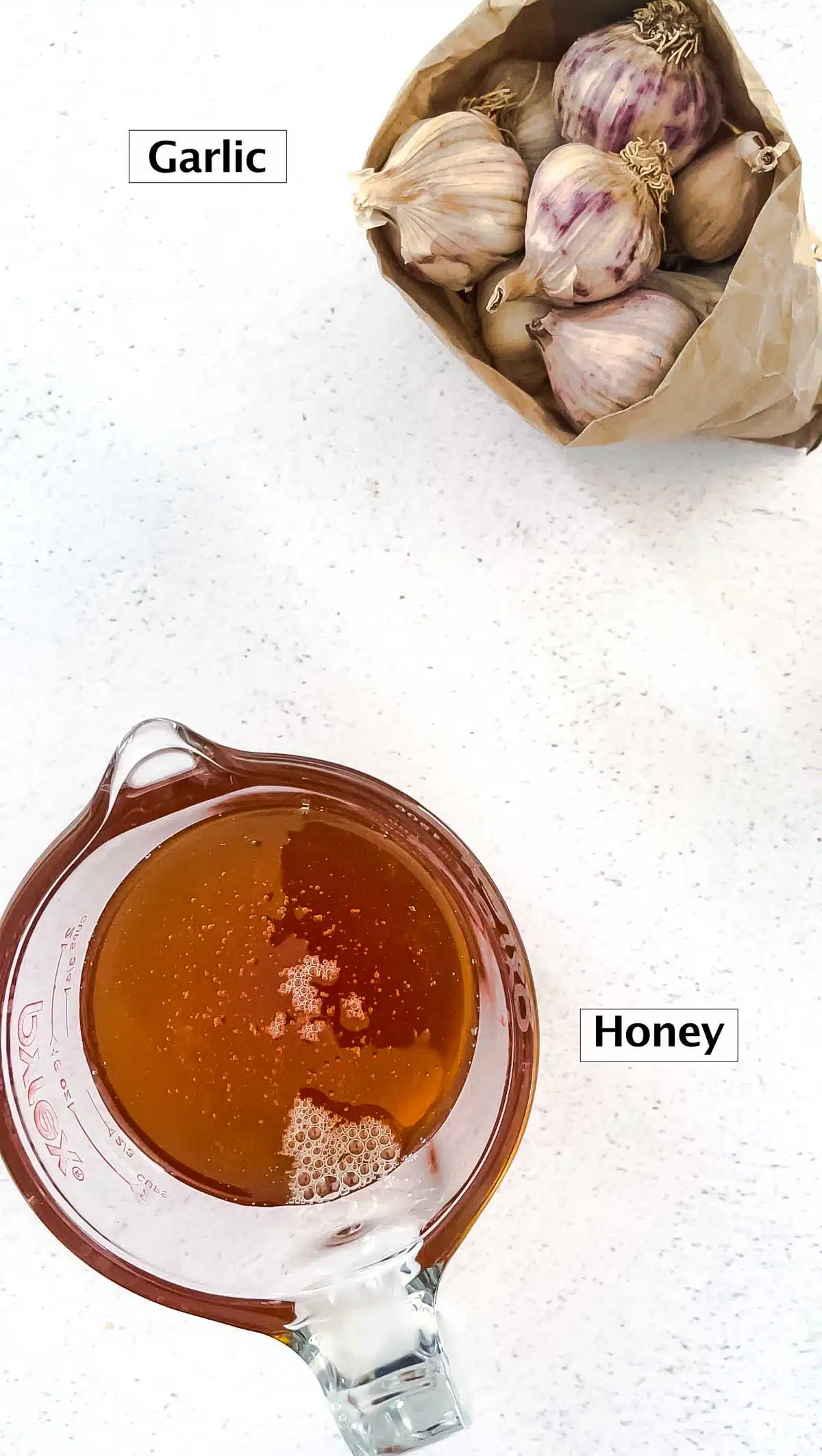
- Whole Garlic Cloves – you’ll need several heads of garlic for this ferment. The amount used is dictated by the size of the jar used. I had a large jar, 750ml / 25oz, which used roughly 12 small heads of garlic.
- Local Raw Honey – this is essential as it contains the bacteria and yeast needed for fermentation to occur. As this ferment is also used for its medicinal benefits, raw honey/unpasteurized honey is the best choice because it has the highest nutritional compounds to offer.
Once this has fermented it will be used quickly. While it might be a bit laborious to peel a tonne of garlic cloves, I do recommend it. That way you’ll have fermented garlic in honey for many months, not just a week.
How To Make Fermented Garlic Honey
This is as simple as it gets! Peel the garlic and cover it in honey. However, it is also important to make sure the cloves you’re using are not bruised or spoiled. This can and will likely affect the fermentation process. So, take the time to look over them once peeled, chop off any bits that need it or discard the whole clove if necessary.
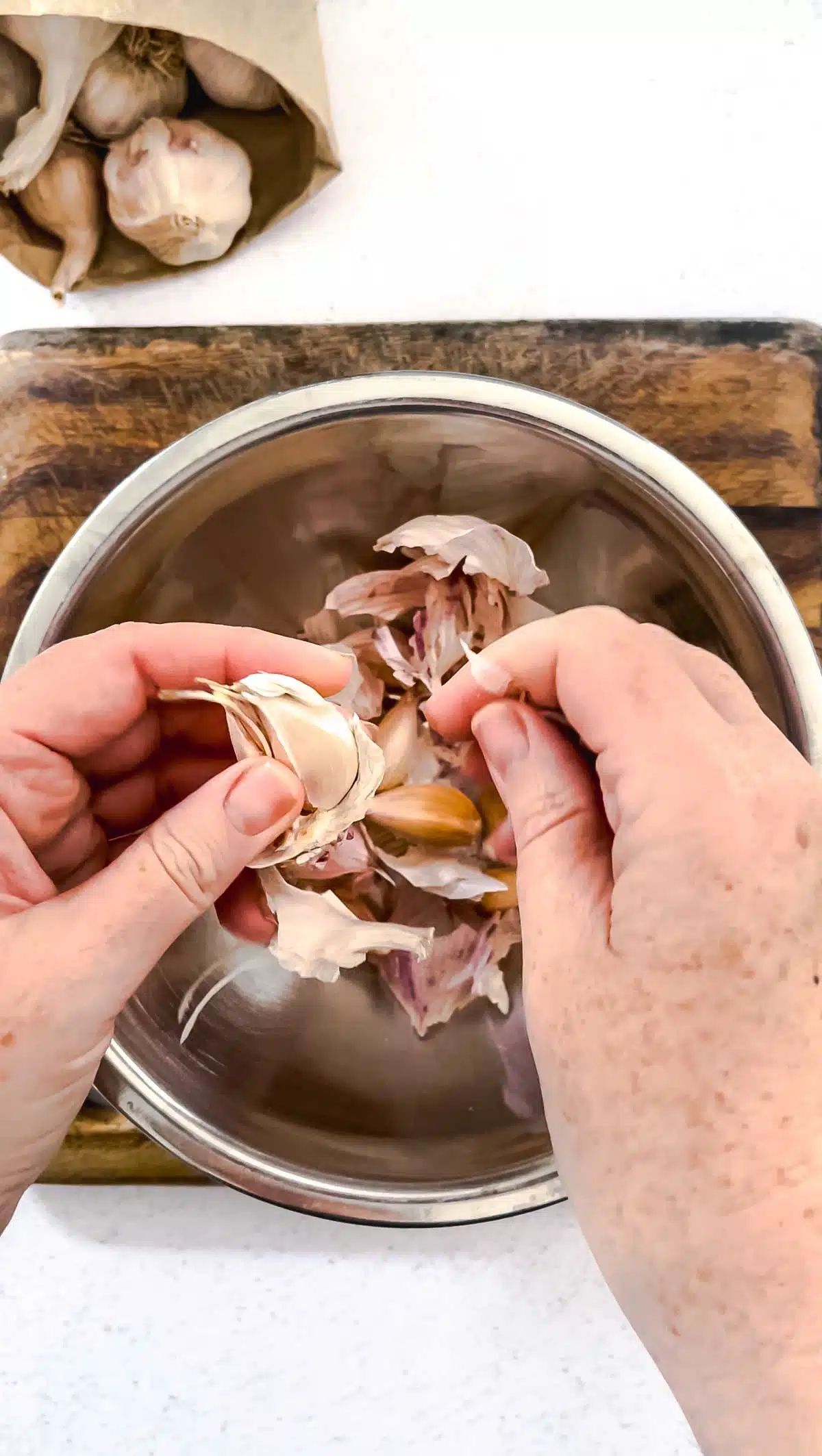
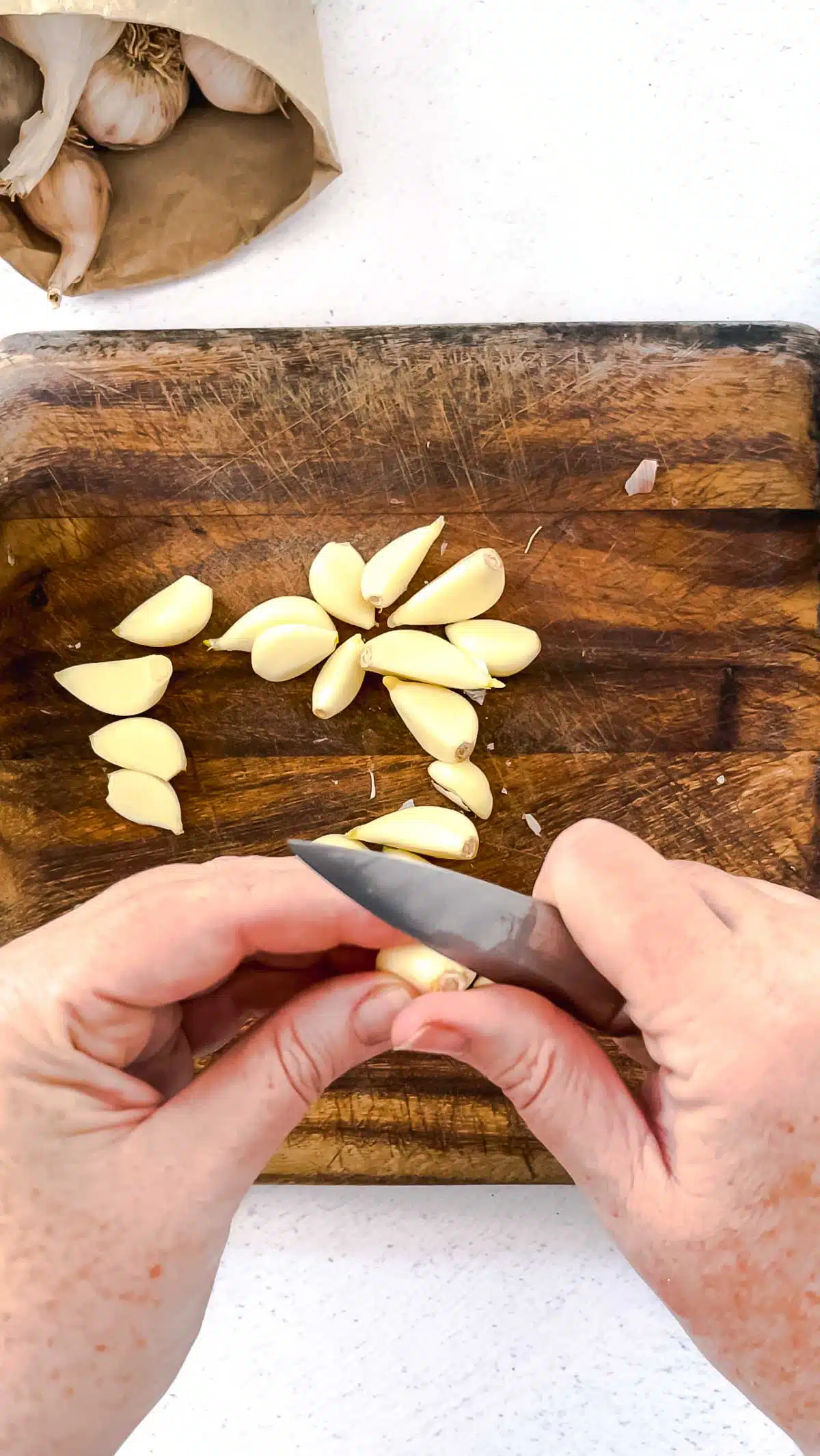
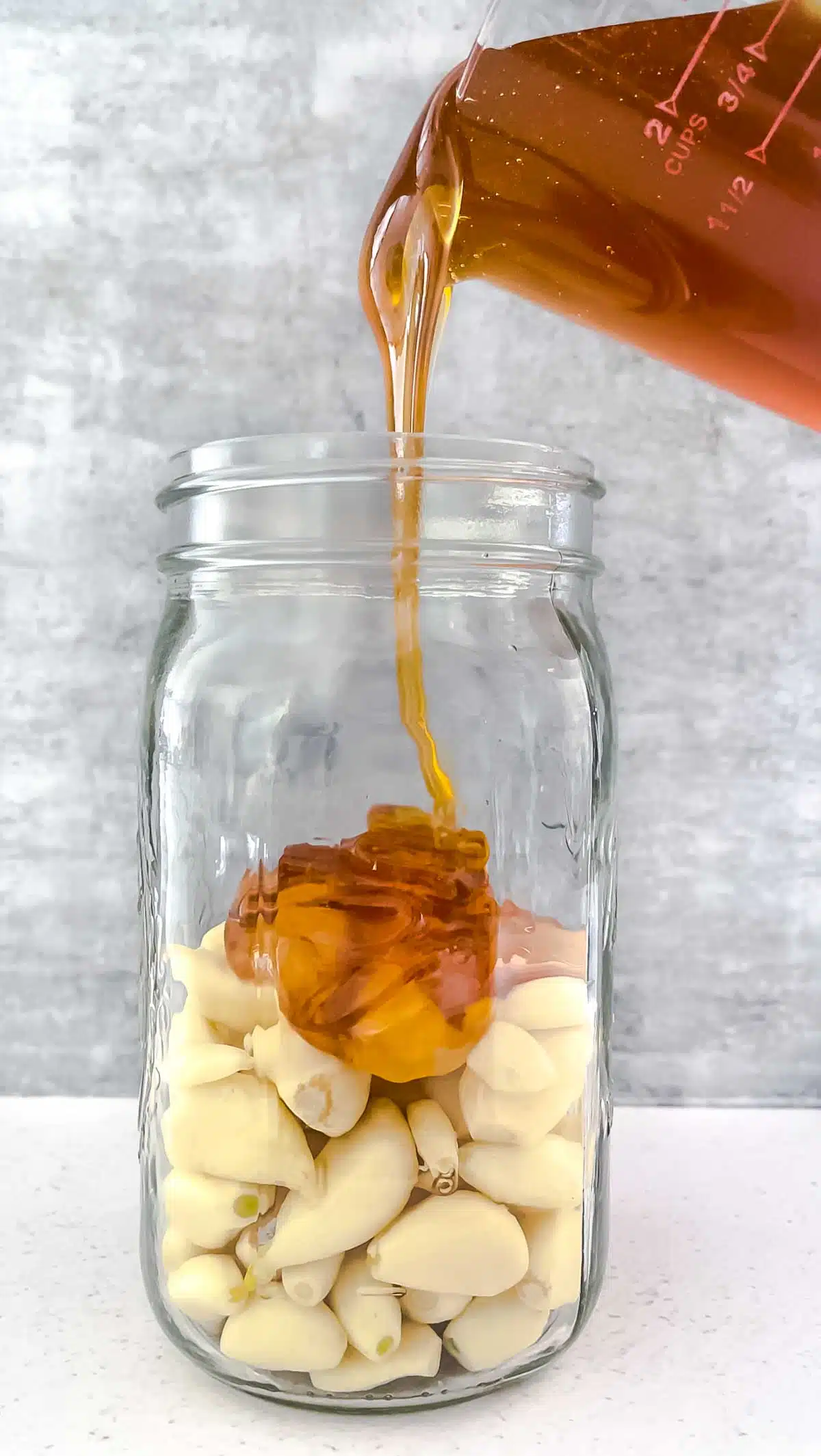
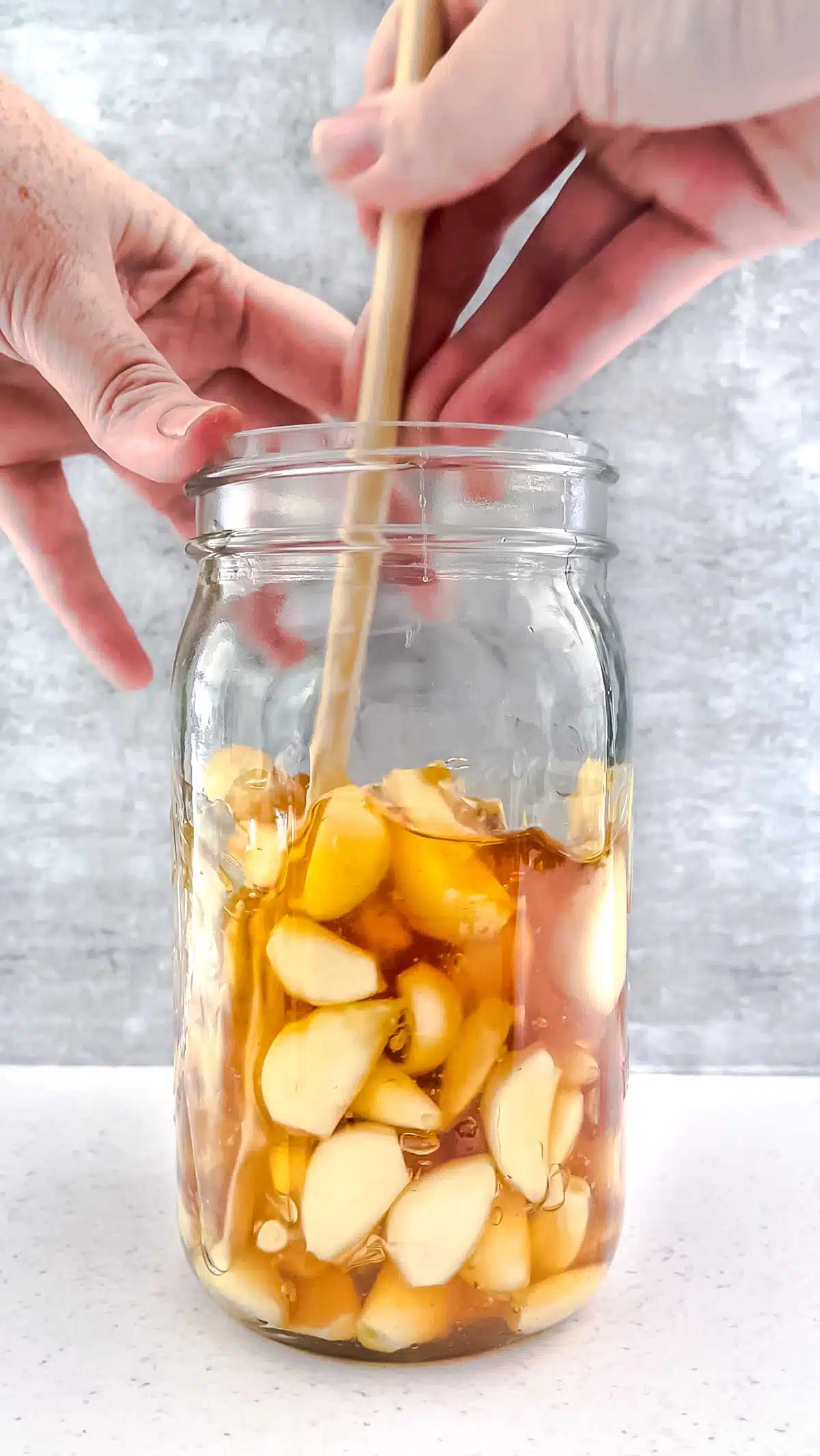
- Peel all the garlic cloves and cut the bases off that were attached to the root.
- Cut out any bruised bits or discard the whole clove in need.
- Place the peeled raw garlic cloves into your very clean glass jar and pour honey over the top leaving roughly 5cm (2 inch) headroom. A little more is OK too.
- Stir to coat all the garlic cloves. I like to use a chopstick for this. It’s the easiest way to move all the garlic around.
- Pop the lid on the jar and set it aside to ferment in cool place out of the sun for a month at room temperature. Be sure to turn the jar a few times every day to help keep the garlic submerged in the honey. Just tighten the lid before you turn it or you’ll have honey spilling out. You could also use glass weights to weigh down the garlic if you have them.
Note: Gases build up during fermentation that can lead to exploding jars! As such, for the first week of fermentation, it’s important to ‘burp’ the jar a few times a day. To do that you simply loosen the lid, then tighten it again. You may hear a pop as you do it, which is just the gas being released.
Fermented Garlic Honey Uses
You can use this ferment in any way you like once ready.
- Traditionally – take a clove and a spoonful of honey from the jar and have them as is. The garlic is much more mellow after sitting in the honey for a month. The honey will also have taken on a delicious garlic flavour.
- Add to salad dressings for a boost of probiotic goodness.
- Chop some garlic cloves and stir them into savory labneh. Serve with a drizzle of the honey.
- Add a little of each to cooked rice or any savory meal to enhance the flavour.
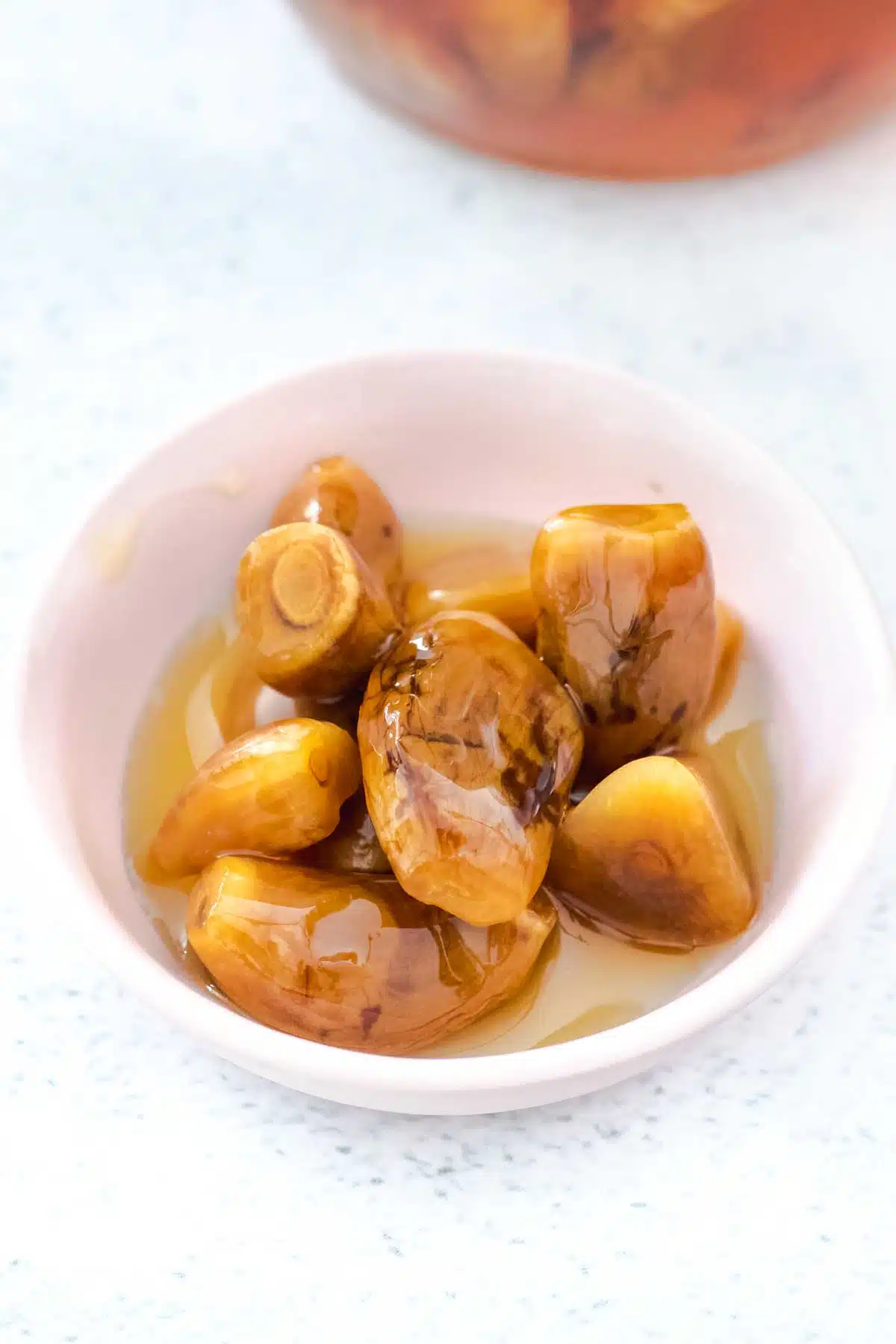
Variations
Adding in spices like red pepper (chili) flakes or nigella seeds is something many people like to experiment with. Just keep in mind the darker the spices used the more the honey will change colour. Nigella for example will produce a very dark honey over time. I also find this one affects the taste quite a lot, making it slightly bitter.
Chili flakes give you a nice, warmed garlic ferment, but don’t use too much or it will become the predominant flavor. Start with ½ a teaspoon in a large jar. Less in a smaller one.
Storing/Freezing/Make Ahead
This is the ultimate make-ahead recipe! Get this started in the fall/autumn so it’s ready for you to include as part of your immune boosting winter toolbox. The recipe is not suitable for freezing.
FAQ
Fermented garlic with honey is a very old, natural remedy that is brimming with good bacteria. It was used historically for its antibacterial, antiseptic, antiviral, antimicrobial, and immune-boosting properties. It’s particularly favoured in the cooler months for its immune system support, and to soothe sore throats. A great food as medicine to have in our autumn/winter toolbox. On top of that, we have the medicinal properties of garlic to consider too. You can find more about that in my Garlic Miso recipe.
Yes! And you can reap the rewards of all the beneficial properties it contains. They’re two natural ingredients we use in our cooking almost daily so there’s absolutely no issue enjoying them when fermented either.
It’s possible though unlikely due to the fermentation process. However, as always with a ferment it’s best to let your senses guide you. If the garlic or honey are growing pink, blue, green or black mould, discard the jar immediately. If it tastes or smells rancid or sour the same should be done.
A honey ferment has a long shelf life. However, for flavour purposes, this ferment is best used within 12 months. I’ve had one sitting around for two years and the garlic crystalised a little. Still fine to eat but I suggest 12 months for maximum taste.
Want More Fermenting Ideas? Take A Look At These!
If you try this recipe, I’d love to know. Leave a comment, rate it, and remember to tag @wholenaturalkitchen in your pics or reels on Instagram, Facebook or TikTok!
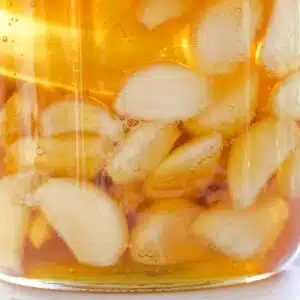
Fermented Garlic Honey
Equipment
- 25oz/750ml glass jar
- Glass weights optional
Ingredients
- 12 small heads garlic (see note 1)
- 1 pint raw honey 500ml
Instructions
- Peel all the garlic cloves and cut the bases off that were attached to the root.
- Cut out any bruised bits or discard the whole clove in need.
- Put the peeled garlic cloves into your very clean glass jar and pour the honey over the top. Stop about halfway and give the jar a stir with a clean chopstick to ensure all the cloves are coated. Top up with the remaining honey leaving roughly 5cm (2 inch) headroom. A little more is OK too.
- Be sure you turn the jar a few times every day, as this helps to keep the garlic coated in the honey. The garlic will eventually sink to the bottom of the jar and then there will be no need to keep doing this. You could also use glass weights if you have them.
How to use this fermented garlic honey
- When ready (you'll notice the honey has become much more liquid) – you can take a garlic clove and a spoonful of honey from the jar then eat it as is as a cold and flu remedy. It's great for sore throats this way! Immune-boosting at its best. You can also chop up the garlic cloves and add them to salad dressings with some of the honey or sprinkled over meals if you'd prefer that.
Video
Notes
Nutrition
Pin This Recipe For Later
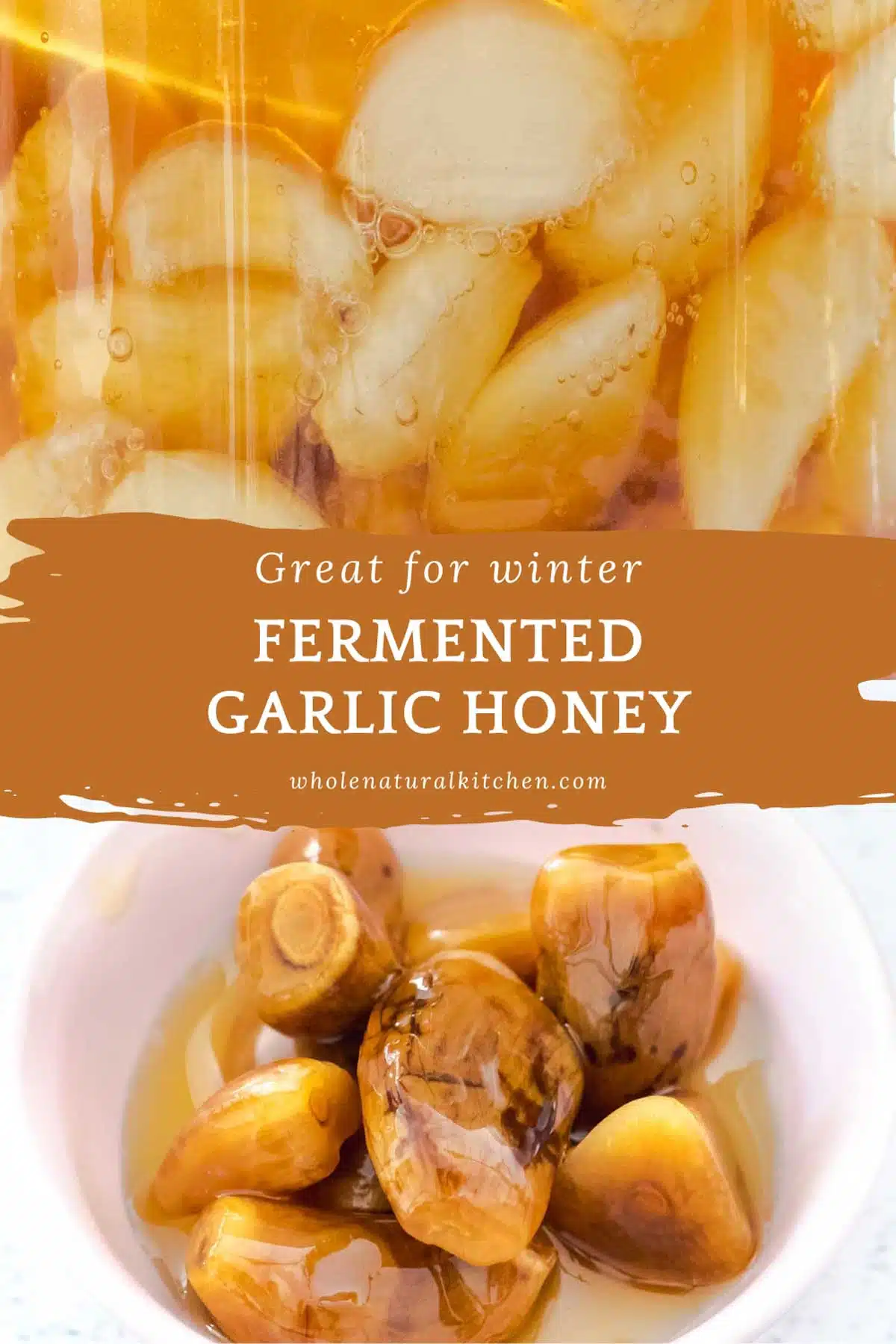
NEVER MISS A THING!
Follow me on Facebook, Instagram, and Pinterest to keep up to date with all my latest recipes, hints, and tips.

Hello, can I store this in the fridge after the fermentation process?
Hi Elaine, there’s no need to keep this in the fridge, but you can if you’d like to. Move it to the fridge only once its fermented for a couple of weeks and the hunny has become much thinner/runnier.
Hi! thank you so much for the detailed steps, very helpful! The bubbles and the gas, etc, all happened as you mentioned…but one morning during week 1 I came to flip the jar around and had seen the top had popped off (lots of pressure!). I just had my first teaspoon after waiting the prescribed period you mentioned and it doesn’t taste “bad”? but was coming back to read your blog and other reviews/questions to see if any one had that same problem and maybe I shouldn’t eat anymore? thoughts?
thank you again!!!
Hi Nikki – I apologise for the late response, I missed the notification. It sounds to me like your ferment was still very active at that point, which is a good thing. You’re right in that the lid pop-off was due to gas build up. Better the lid pops off than the jar explodes! Sight, smell, and taste are our best guides with ferments. If you can’t see any visible mould (unlikely with a honey ferment), it smells sweet with a hint of pungency (like sweet garlic), and also tastes like that – your honey garlic ferment is perfect. I would continue to burp your jar for a few more days because it does sound quite active. It will eventually settle down and you won’t need to keep doing that. Just make sure all the garlic is submerged under the honey so it all ferments. Hope you enjoy it when you sart using it!
Would it be ok to put other ground herbs/spices in the honey along with the garlic? Would it negatively affect the fermentation process?
Hi Angela – I’ve added nigella seed to one once before to test this out and I really don’t recommend it. For one, the honey can become very dark (in this case it went black), but two, it also ends up tasting very bitter.
Is it better to use wildflower or clover honey for this?
Hi Errin, the most important thing is using raw honey. After that it’s really up to you and which taste you prefer. Clover for something more mild and sweet or the wildflower for something a little stronger with floral and fruity notes. In the end the honey is infused with the garlic so it will be the base flavour of the honey you choose infused with a garlic essence. If you’re unsure perhaps start with the clover. Hope you enjoy it!
I have had some in the pantry for 2 weeks and its not bubbly….. should I start over? What did I do wrong?
Hi Laurin – it doesn’t remain bubbly for much longer than a day or two. That really big fizz of bubbles you see in my picture in the post above occurs when the initial fermentation is underway. It settles down and looks like garlic in slightly runnier honey after that. If you didn’t check on it in those first few days you might just have missed the bubbling. No need to start again. Just leave it for a few more weeks then open the jar, give it a sniff and a little taste. If you like it as is you can start using it. If you find the garlic is still a bit too strong to use raw leave it for a couple more weeks.
Hi Gabby 🥰. It’s been about 6 weeks since I started my garlic honey fermentation. I think I did it right. It looks good and I popped open lid and then I turned it over as it’s been floating awhile…. I used honey comb honey with a little honey 1 inch size “ comb” in it . Is that ok. Also there are pieces of the comb floating in it .? I think it be fine but not sure? Also how do you know when it’s ready to take. ? The Garlic has turned a beige color . Thank you. I don’t notice anything growing in it. I do see on some pieces the end parts on some pieces that are a little brown where I had cut but I think that is normal looking. Nothing growing on it…. Thank you.
Hi Roberta! I haven’t actually made this ferment with any honeycomb in it before. However, there isn’t anything on the comb that wouldn’t also be in the honey so I can’t see why there’s any issue with using it. As to when it’s ready – that’s really up to your tastes. Some people like to leave it a little longer because they find the garlic is too pungent when it hasn’t fermented for long. You can definitely start using the honey straight away but just take out one of the cloves, slice a bit off and have a taste. If you like it you can start using it. If you think it’s still a bit too strong leave it a few more weeks and try again. The garlic will darken over time as it takes on more honey. You can see an image of what it looks like if you scroll up to the ‘using the finished product’ section above. Hope you enjoy it!
Absolutely so delicious!
It’s quite possibly one of my favourite recipes of all time!
Hi! I’ve tried to make this but I believe I used too little garlic and have also kept the lid loose/burped. Can I save it by adding more garlic and closing the lid? Or do I need to start over?
Hi Danielle – I think this was just a repeat of your question above? As mentioned though – maybe just get this one in the fridge and start another one. The one in the fridge will still ferment but it will be slower so I’d leave it there a couple of months before starting to use it. That way the garlic will have started to mellow and the honey will have taken on the garlic flavour.
I started to make this, but I think I used too little garlic – and I’ve also kept the lid loose. Is there any saving it? Or so I need to start all over?
Hi Danielle – It’s hard to say without actually seeing the jar, but my suggestion would be to pop that one in the fridge where it does keep fermenting but at a much slower rate. Then start over with a new jar. Make sure you fill it at least 1/2, or better yet 3/4 of the way with garlic before covering it in honey. Whether the lid is tight or not is not as important as whether the garlic is kept submerged under the honey. I have glass weights that I will often use as a way to keep the garlic from floating. If that’s in the the jar I don’t tighten the lid much. If I don’t have any weights available to use then I do tighten the lid so I can turn the jar a few times a day. Turning it upside down then right side up a few times means the garlic is always being coated in the honey. And yes, this method does mean the jar needs to be burped every day to release the gas. Hope that helps. Happy fermenting!!
Hi, question, I just made this for the first time. Mine has caused my jar lid to bulge (despite being burped every day since made on Saturday) and when burped it almost pops and then bubbles like crazy and overflows the jar. The recipe I had used said to leave 1” at the top. My garlic was very potent and I slightly crushed it before putting in the jar. Is it normal for it to bubble this much? Did I overfill it? I am concerned about botulism, I saw a video about a woman warning about this because she didn’t burp it and her family all ingested it. Any help you could give would be great. Thanks!
Hi Kristin – Crushing the garlic has likely caused your mix to become extra bubbly. I assume it’s VERY active given it has made the lid bulge and caused it to overflow even when burped. With a ferment this active I would definitely recommend burping it several times a day. In saying that, it will only remain this active for a few days to a week and will then settle down. Was the lid of the jar rusty at all? If not I wouldn’t worry, but I would suggest decanting the entire mix into another (very clean!) jar with a lid that closes properly. Once the fermentation dies down you will want to keep the fermented garlic in honey airtight. If the lid was rusty – I personally would throw the entire batch away and start again. Not so much for safety reasons, but the rust can affect the taste of the honey making it quite metallic. I know others may opt to keep it but I always err on the side of caution with fermentation. As to botulism – I have a short – and I hope informative – paragraph on that towards the top of this post that is worth reading. Ultimately you will need to decide whether you think your ferment is safe – but again, when I was a novice fermenter (and certainly still to this day) if I ever have any doubts I toss it out and start again.
This article is great! But it needs to be noted that you have to loosen the lid to burp the jar once a day for a while, or it can explode.
Hi April – Thank you, I had to read back and see what you meant. I make this two ways depending on the jar I have. The way I’ve written it here – you’re quite right, the jar does need to be burped if you’re using a tight fitting lid. I’d use a jar like this if I need to turn the jar a few times a day to keep the garlic submerged (usually when I don’t have any fermentation weights available). Otherwise, the garlic goes in, then the honey, then a glass weight on top to keep the garlic under the honey and then I actually don’t close the lid too tightly at all to ensure the gases can escape. But given I have written ‘tight fitting lid’ here – you’re definitely correct and I’ll update accordingly! Cheers.
Hi, just made mine, however I didn’t leave as much room as I should have at the top and it’s bubbling and overflowing. Is it ok to remove some honey? It will it mess up the fermentation process
Hi Michelle – yes definitely remove some honey and it will be fine. I’d suggest pouring the garlic into a new, very clean jar, and tipping in as much of the honey from there as you can leaving sufficient space this time. It does get very bubbly in the first few days but settles down after that.
Can mold grow on garlic in the honey? I just turned my jar (I put it together about a week ago) and noticed 3-4 cloves with a green tinge on their tips. Is the whole batch ruined? Thank you in advance for your response.
Hi Jorge
I have never had mould growing in this particular ferment but it’s not impossible. Garlic can go quite neon green and/or blue due to a chemical reaction occurring during the fermentation process. When it’s like this it’s a simple colour change and safe to eat. I suggest Googling “green garlic fermentation”, which will return several images of what it looks like. I see this mostly in brine ferments but have heard others say it has appeared in their honey ferments too. I’ve been looking for a picture I had to share here but annoyingly I can’t find it so Google will be your best bet. If something in the ferment is mouldy it won’t simply have changed colour, you will also see a powdery like growth along with that colour (like green mould on bread for example, or green/pink mould in yoghurt). However, if you’re new to fermentation and you feel uncertain about whether the garlic has simply changed colour or has mouldy growth on it I would recommend discarding it. Safety always comes first!
Love this recipe, so good to have on hand for so many occasions. Have made it before.
That’s so wonderful to hear Fernanda! I love having it on the shelf too.
Hi Gabby! Elaine just opened her jar of fermenting garlic honey and we each ate a couple of cloves. Feel healthier already! Haha! Great (easy) recipe. Thank you. Keep well.
Oh amazing! I’m glad you love it. It’s honestly one of the most delicious things in my kitchen and the health benefits are an added bonus!